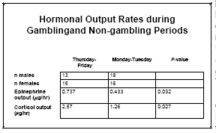The significance of economic exchange has long fascinated anthropologists. Mauss dedicated an entire volume to the social functions served by gift-giving, Malinowski’s seminal work focused its attention on the kula transactions of the Trobriand Islands, and Benedict interpreted the potlach festivals among the Kwakiutl. Gambling, too, has its own anthropological literature that documents and discusses the logistics, functions, and meanings of gambling in cross-cultural settings. But Schmitt, Harrison, and Spargo (1998) have taken the subject of gambling out of the anthropological realm of the social and into that of the physical and biological [1]. The authors conducted their study among the Kimberley Aborigines of western Australia, a group with documented history of gaming behaviors. Regarding their gambling, a Royal Commission noted in 1935, “He will… if losing, divest himself piece by piece of his clothing to enable him to continue the game; but, with money, his gambling instincts are aroused to the fullest extent. It may be that, with closer supervision and by taking a greater interest in this attribute of the native, his squandering habits might be checked.” Such a colonialist attituted may seem absurd to modern readers, but poor health conditions among the Aborigines are still linked by some to their gambling behaviors [2]. The group consists of 350 members living about 600 kilometers from the nearest town. Strongly tied to the schedules of distribution of employment checks and government aid, the majority of gambling was concentrated on Thursdays and Fridays. Using a sample of adult volunteers (aged 19-67), the authors collected urine samples and blood pressure readings from the group during the two time periods of Monday/Tuesday and Thursday/Friday.
The results reveal a significant differential in the mean rates of cortisol and epinephrine output between the two time periods. Both cortisol and epinephrine are hormones released naturally in the body; the latter is sometimes called “adrenaline.” The differences in diastolic and systolic blood pressures approached discernability, but still failed to be significant at the .05 level [1]. Frankenhaeuser (1989) proposes a model in which mental exertion determines epinephrine output while negative affect determines cortisol levels [3]. Gambling activities often involve high levels of mental exertion and affect, which may explain the increased output rates observed during the gambling period. Hunter and Spargo (1988) advance the argument one step further and posit that gambling among the Kimberley Aborigines is a cause of poor nutrition and community health [2]. Before we accept their conclusions, several caveats apply. Members of the Kimberley community in which the authors performed their work had an extremely high degree of relatedness; that is; nearly all subjects were related to one another genetically. Thus, the sample is hardly representative of the larger gene pool. And the possibility always exists that the high hormonal levels are not a reflection of increased gambling activity, but rather of the anticipation of getting paid or other correllated phenonmena. But the authors are not claiming universality for their findings, and perhaps the significance of the study lies not in the results at all but in the methodological considerations raised by studying gambling cross-culturally. Just as it would be fallacious to consider the 4th of July to be identical to Bastille Day, so must the temptation be resisted to equate a risk-taking behavior in one culture with a risk-taking behavior in another culture just because they share the same mechanism or equipment. A poker game in culture A should not automatically be analyzed the same way as the same game in culture B. The complications created by this idea for anthropological inquiry are great; they may be even greater for the diagnosis and treatment of disordered gambling.
Sources:
- Schmitt, L. H., Harrison, G.A., and Spargo, R.M. (1998). Variation in epinephrine and cortisol excretion rates associated with behavior in an Australaian aboriginal community. American Journal of Physical Anthropology 106: 249-253.
- Hunter, E. M. and Spargo, R. M. (1988). What’s the big deal? Aboriginal gambling in the Kimberley region. The Medical Journal of Australia 149: 668-672.
- Frankenhaeuser, M. (1989). A biopsychosocial approach to work life issues. International Journal of Health Services 19: 747-758. as cited in Schmitt, Harrison, and Spargo (1998).
This public education project is funded, in part, by The Andrews Foundation and the National Center for Responsible Gaming.
This fax may be copied without permission. Please cite The WAGER as the source.
For more information contact the Massachusetts Council on Compulsive Gambling,
190 High Street, Suite 6, Boston, MA 02110, U.S.





